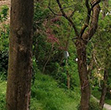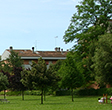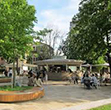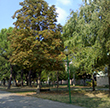Sei in: Home » discover the area Nature and Environment City parks Public Gardens of Cesena
discover the area
Public Gardens of Cesena
Via Giuseppe Verdi
47521 Cesena - Centro Storico (FC)

Description
It is located in the centre, with benches and busts of famous citizens, besides a rich vegetation.
PUBLIC GARDENS
Open-air museum of cast-iron street furniture
History
Cesena's public garden was created in the first half of the nineteenth century on a piece of land which Count Paolo Neri bequeathed to the town. The garden is adjacent to the civic theatre and runs alongside the town's main thoroughfare. It was laid out on rigidly symmetrical axes, in the neoclassical style, with echoes of the mazes and concentric circles typical of the Renaissance garden. The area surrounding the gardens was later developed. The countryside was built over and the gardens lost their central role as a public amenity and place of leisure to assume an almost "monumental" value. Busts, inscriptions to eminent civic dignitaries and a pair of large stone planters replaced the obelisks, which were demolished. In 1946, a road, Via Verdi, was opened for vehicle traffic through the gardens, thus effectively cutting them in two.
The renovation
The garden's renovation (2007-2008) was part of an urban renewal plan by architect Pier Luigi Cervellati, who first studied the archives in his endeavour to give back to Cesena a public space which had played an important role in the town's history.
The gazebo
At the centre of the gardens, where the two stone obelisks once stood, there is now a 12-sided cast-iron gazebo (10m wide and 8m high). Also called a cassa armonica ("soundbox") in Italian, the gazebo is part of the range of street furniture which over a century ago was made to enhance public spaces. This elegant, airy structure offers shelter and is a focal point of the gardens, a recreational space and an ideal meeting place.
Statuary
Sculptures of characters of the commedia dell'arte dot the garden's western wall, beyond which the side of the civic theatre can be seen. The cast bronze statues are the work of sculptor Domenico Neri who donated them to the town. These characters are an evocative reminder of Italy's socio-cultural history even though they belong to a form of theatre which emerged in the 16th century and has since disappeared.
The open-air museum
After their renovation, the 19th-century gardens were decorated with elements of period street furniture in the area around the gazebo. The display is designed to form an open-air museum of examples of street light poles and drinking fountains. The street furniture installation is the work of the Neri Foundation Italian Museum of Cast-Iron, which owns eight of the 12 poles. The poles have different styles, but they all share the same taste for monumentality and elaborate detail, two elements which only the art of casting iron can successfully combine.
Accessibility
By bicycle, car and bus (line 4).

















